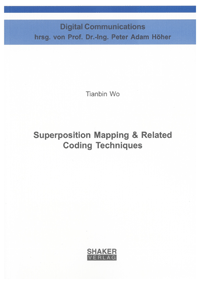
Shop : Rezensionsexemplar
Shop
Rezensionsexemplar

April 2012
Tianbin Wo
Superposition Mapping & Related Coding Techniques
Since Shannon’s landmark paper in 1948, it has been known that the capacity of a Gaussian channel can be achieved if and only if the channel outputs are Gaussian. In the low signal-to-noise ratio (SNR) regime, conventional mapping schemes suffice for approaching the Shannon limit, while in the high SNR regime, these mapping schemes, which produce uniformly distributed symbols, are insufficient to achieve the capacity. To solve this problem, researchers commonly resort to the technique of signal shaping that mends the symbol distribution, which is originally uniform, into a Gaussian-like one.
Superposition mapping (SM) refers to a class of mapping techniques which use linear superposition to load binary digits onto finite-alphabet symbols that are suitable for waveform transmission. Different from conventional mapping schemes, the output symbols of a superposition mapper can easily be made Gaussian-like, which effectively eliminates the necessity of active signal shaping. For this reason, superposition mapping is of great interest for theoretical research as well as for practical implementations. It is an attractive alternative to signal shaping for approaching the channel capacity in the high SNR regime.
This thesis aims to provide a deep insight into the principles of superposition mapping and to derive guidelines for systems adopting it. Particularly, the influence of power allocation to the system performance, both with respect to the achievable power efficiency and supportable bandwidth efficiency, is made clear. Considerable effort is spent on finding code structures that are matched to SM. It is shown that currently prevalent code design concepts, which are mostly derived for coded transmission with bijective uniform mapping, do not really fit with superposition mapping, which is often non-bijective and nonuniform. As the main contribution, a novel coding strategy called low-density hybrid-check (LDHC) coding is proposed. LDHC codes are optimal and universally applicable for SM with arbitrary type of power allocation.
Superposition mapping (SM) refers to a class of mapping techniques which use linear superposition to load binary digits onto finite-alphabet symbols that are suitable for waveform transmission. Different from conventional mapping schemes, the output symbols of a superposition mapper can easily be made Gaussian-like, which effectively eliminates the necessity of active signal shaping. For this reason, superposition mapping is of great interest for theoretical research as well as for practical implementations. It is an attractive alternative to signal shaping for approaching the channel capacity in the high SNR regime.
This thesis aims to provide a deep insight into the principles of superposition mapping and to derive guidelines for systems adopting it. Particularly, the influence of power allocation to the system performance, both with respect to the achievable power efficiency and supportable bandwidth efficiency, is made clear. Considerable effort is spent on finding code structures that are matched to SM. It is shown that currently prevalent code design concepts, which are mostly derived for coded transmission with bijective uniform mapping, do not really fit with superposition mapping, which is often non-bijective and nonuniform. As the main contribution, a novel coding strategy called low-density hybrid-check (LDHC) coding is proposed. LDHC codes are optimal and universally applicable for SM with arbitrary type of power allocation.
Schlagwörter: Kanalcodierung; Modulationsverfahren; Informationstheorie
Digital Communications
Herausgegeben von Prof. Dr.-Ing. Peter Adam Höher, Kiel
Shaker Verlag GmbHAm Langen Graben 15a52353 Düren
Mo. - Do. 8:00 Uhr bis 16:00 UhrFr. 8:00 Uhr bis 15:00 Uhr
Kontaktieren Sie uns. Wir helfen Ihnen gerne weiter.

